I don’t see enough American Coots. That’s a comment you probably don’t hear much in regular conversation — or even from birdy people. The coot is not a bird that inspires viewing frenzies the way an owl does. I’ve heard some people call coots “trash birds” — a pejorative I never use for any animal, but a term that 10,000 Birds describes this way:
“Trash bird” is controversial birding lingo for any species that is so ubiquitous in a location that it surpasses unremarkable and becomes truly irritating.
Recently, I was at an urban wildlife area where a bustling raft of several hundred coots inspired barely a nod, while photographers on the boardwalk trained their lenses on few mergansers feeding in the shallows … like this female Hooded Merganser.
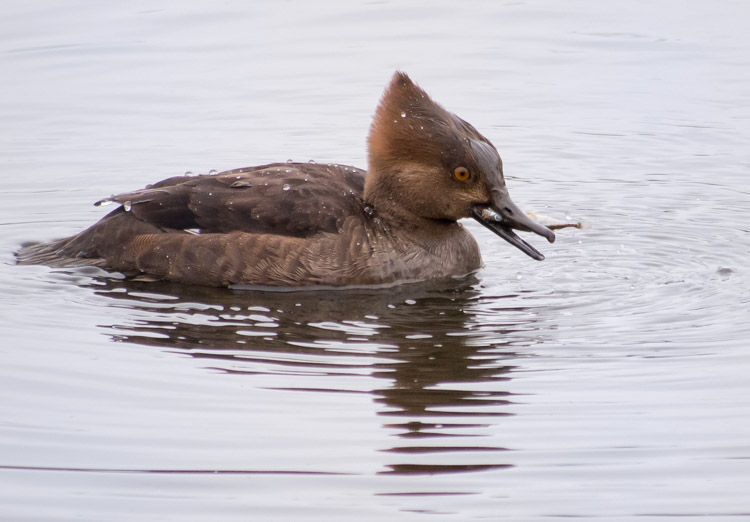
Female Hooded Merganser on Lake Washington – ©ingridtaylar
Putting aside (if I can) our own species’ arrogance — that we actually have the audacity to rate any other animal as “trash” — I find American Coots to be fascinating in more ways than one. I know there are other photographers who share my affection and respect.
First, there are the magnificent and giant lobed toes. Photographer Mia McPherson captured those coot toes here, all frosty from a winter’s romp.
Then there are the behavior displays and territorial arguments, something I’ve been able to photograph (close up) just one time, on Mountain Lake in San Francisco’s Presidio. I was new to Coot behavior and the signs leading up to a fight, so this sudden tussle took me by surprise. I snapped just two frames before they split off.
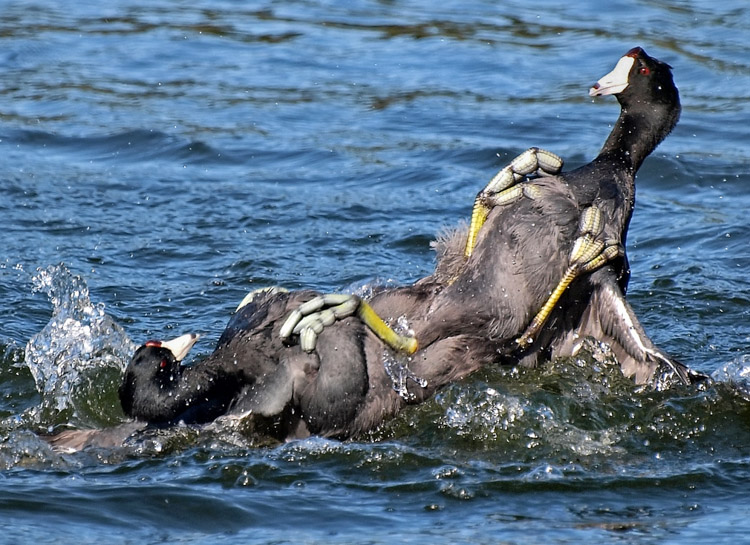
American Coot Tussle – ©ingridtaylar
Last year, I wrote about the coots’ flocking cohesion as they marched, single file, in and out of the primordial soup of Lake Union in Seattle.
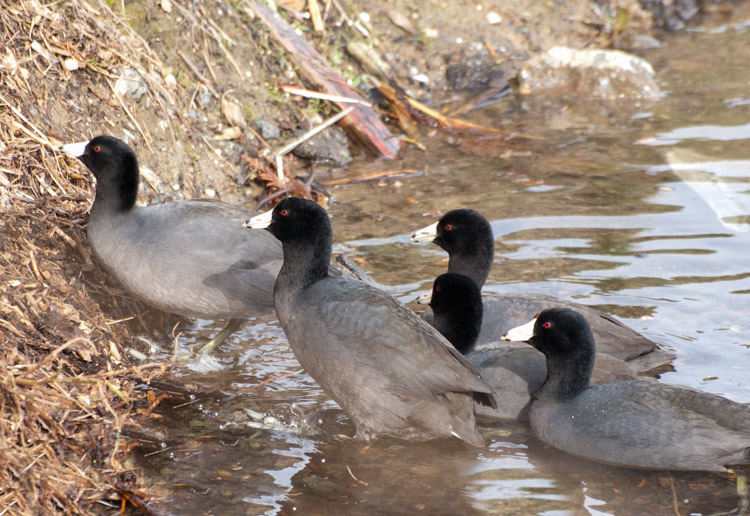
American Coots at Lake Union – ©ingridtaylar
Then last week, Hugh and I were lucky to come upon a group of coots off the shoreline at Union Bay Natural Area in Seattle, bobbing for greens like a flock of fishing floats.
“The filtering beak allows the Coot to filter out the gulps of water and mud it takes in while also taking up vegetation or small fish or insects. Instead of completely diving into the water the Coots may also act like ducks and simply dip their head in and grab a beak full of water and various other things.”
~ From the American Coot website
This video shows just a hint of that behavior. I was shooting at full extension here, to show the foraging behavior and the setting of the birds against the urban environment of the 520 floating bridge. They surprised me with a sudden flush toward the shore.
This mass movement brought the coots within easy reach of my lens for 20 minutes or so. They’d collect, huddle and preen on this mud peninsula. Then, on some cootish signal, they’d head out again to forage before either flapping or swimming back toward us and to their refuge again. These photos show snippets from our interlude with the Lake Washington coots. They were shot just a bit earlier but at the same location where I photographed the heron that same day.
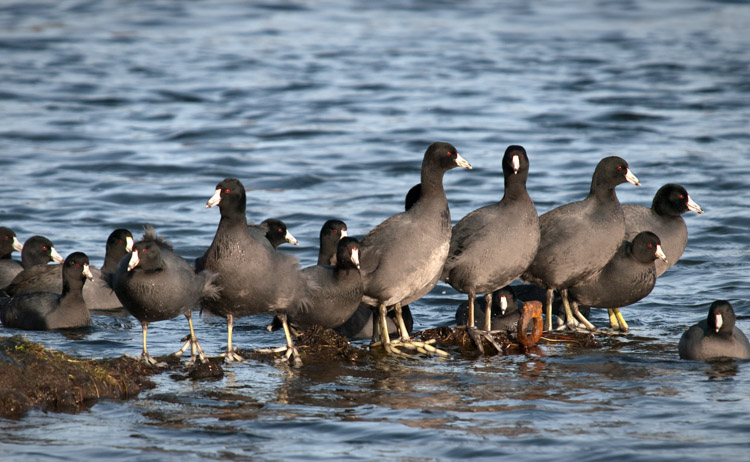
Coot Island – ©ingridtaylar
These two found their own private reed paradise, adjacent to the rest.
This photo shows part of the flock heading back out to forage.
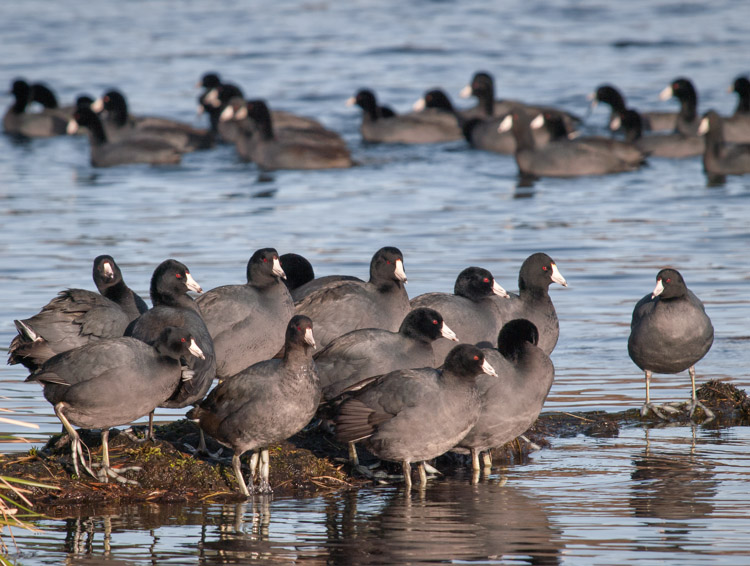
Heading back out to sea – ©ingridtaylar
Here you can see how the light that day favored this one peninsula … where the coots just happened to congregate.
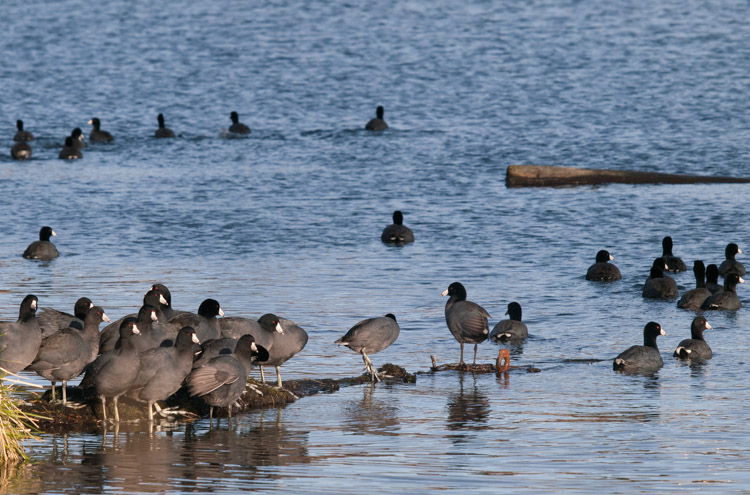
The forage – ©ingridtaylar
They’d leave the island one by one, until the last coot standing couldn’t stand the solitude. He or she would dive in and the whole flock would repeat the same routine several times over until they finally paddled out into the middle of the lake, and out of camera’s reach.
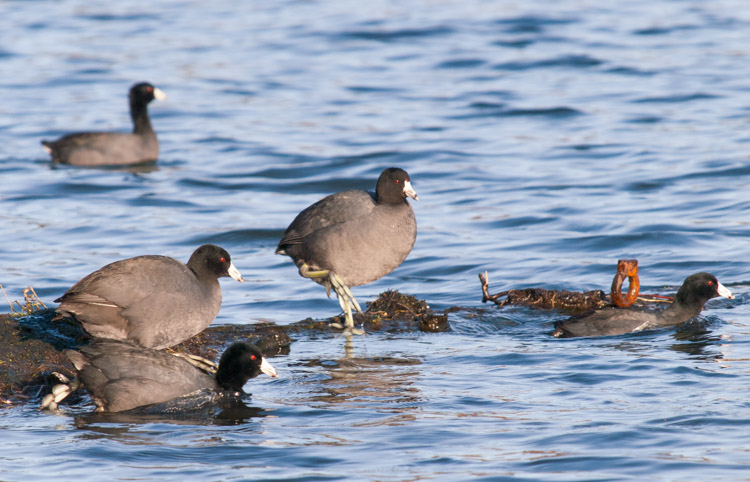
Departure – ©ingridtaylar
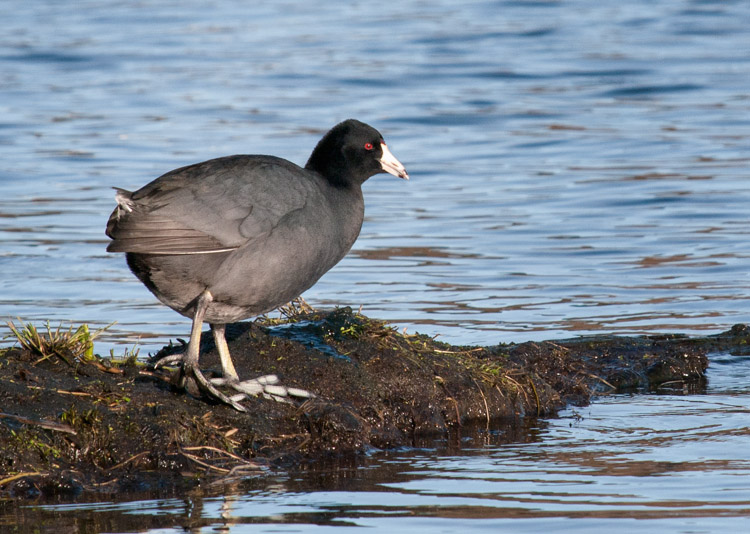
Last coot standing – ©ingridtaylar

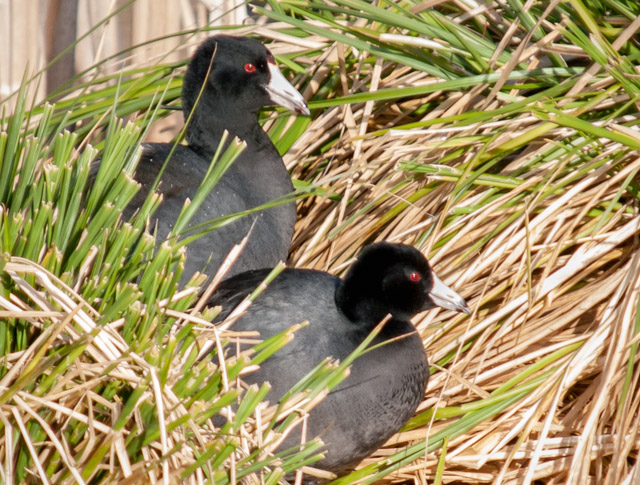
That new lens takes great shots! Are you happy with it? I love coots, and I feel I missed shooting a lot of them, although I did get one I was happy with. It was a monogamous pair that I knew was hanging around. What I love about them are their red eyes against their black feathers. Mine’s here: https://www.caribbeanbiodiversity.com/2012/08/american-coot-fulica-americana.html
Maria, I love the lens. It’s so much faster and brighter than the one I shot with for four years. I haven’t used it as much through the winter because it’s extra weight to carry when I can’t count on the weather — and my little OM-D has much better high-ISO performance than my E-3. But, as the light starts to improve, I’m looking forward to some spring excursions with the Zuiko. I got it in early summer last year, so I missed some of the spring events, like the arrival of the Ospreys.
Not being a photographer or a birder or a frequenter of places where American Coots hang out, I’d never heard of that species before.
I already feel respect and affection for them — based on what I learned of them from Ingrid’s respectful, affectionate blog. And like Maria, I love the unique look of their bright red eyes set against jet black feathers. (Wow, Maria, that is one gorgeous creature your camera captured.)
To those who arrogantly assert that species common in number or appearance are trash, I suggest you get over that dim-witted, self-absorbed prejudice and behold the beauty that resides in every individual — including every cute coot — lovingly made by our mutual-but-far-from-common creator!
Thanks for liking my American Coot CQ! I’m proud of that one since it was my best from a bunch I took. They are truly beautiful with that red eye. To watch them is very therapeutic also.
And you captured the coot in one of his (or her) favorite activities … eating greens. I love the red eye, too. It’s one of the things that draws me to photos of Spotted Towhees, too. Bird eye color, then also the rings around some birds eyes in contrasting hues — thinking of Black Oystercatchers, as one example, with the yellow eye and orange eye ring.
Ah, yes, eating green. Thanks for reminding me of the one of the cute coots favorite pastimes, Ingrid.
My *own* fave food-eating activity is that very thing: enjoying the free gifts of the good green earth to all “her” inhabitants. I’m grateful for “her” fruits, veggies, seeds, nuts, legumes, and, to a lesser degree — until we can grow them commercially as a vegan, organic, polyculture, perennial, permaculture crop — grains. (Sorry I don’t know the right order for all those fancy words, but you can find ’em here: http://www.veganicpermaculture.com)
Coots, you’ve definitely captured my heart big-time now!
Oh, and I shall look up images of Spotted Towhees and Black Oystercatchers now…. unless you already have “spotted” and “catcher[ed]” them (haha) in your camera, Ingrid.
CQ, here’s a link to one of my Spotted Towhee pics: https://www.thewildbeat.com/2011/01/watch-for-towhees-flying-low/
And, my Black Oystercatcher pics don’t come anywhere near the better ones. Maria, do you have any oystercatcher photos? I checked your blog but didn’t find one in a search. In the interim, here’s a good illustration from wiki: https://commons.wikimedia.org/wiki/File:Black_Oystercatcher.jpg
Mia McPherson has lovely shots of a different species of oystercatcher, the American Oystercatcher — similar eyes: https://www.onthewingphotography.com/wings/2012/07/04/american-oystercatcher-in-a-tidal-lagoon/
I just had three succulent snacks — pieces of eye candy, that is — before retiring for the night, Ingrid: your Spotted Towhee (and accompanying rescue story), Wikimedia’s Black Oystercatcher, and Mia’s American Oystercatcher. They’re all striking! Seeing them makes me question why I have not been interested in learning about birds before. Thank you for opening my heart and eyes to so many avian species and, more importantly, to so many fascinating avian individuals.
CQ, I was talking to my mate the other day, commenting on how, although we’ve always enjoyed watching birds, it wasn’t until we started working with them and photographing them that we truly grasped the complexity of their spirits. Now, it’s hard for me to think of a time when I didn’t treasure them through “knowing” them as I do now. They are lovely, clever, attentive, variable, individual and ubiquitous (in the most positive way). My personal nightmare would be Rachel Carson’s Silent Spring.
Whenever I see people mistreat birds in parks, or malign pigeons and Starlings, or simply not notice the splendor of bird life that surrounds us, I think of how they’re missing out on what can only be construed as a miracle of existence. We are graced with these winged beings, always in our midst, flighty and ethereal, filling our urban and suburban caverns with song. I see birds all of the time, but still — every time I see them I cannot get over how magical it is that we coexist, weighted and grounded among flighted entities whose absence would be greater felt than, sadly, their presence is now.
Beautifully put. My sentiments exactly.
CQ, you wrote, “To those who arrogantly assert that species common in number or appearance are trash, I suggest you get over that dim-witted, self-absorbed prejudice and behold the beauty that resides in every individual — including every cute coot — lovingly made by our mutual-but-far-from-common creator!”
You tell it!
Ingrid,
As you know I love all the winged creatures (all creatures really) and I loved reading this post on Coots. They might be “plain” but they are gorgeous in their own right, those red eyes, ivory colored bill, fine dark plumage and those huge lobed feet always draw me in. They are fun to photograph because of their behavior and because they are a challenge to expose properly. They might not grab all photographer’s attention but they sure grab mine!
I especially like the fighting coot image you capture, great action!
CQ, be aware, birds & bird photography is highly addictive. I even dream about them most nights!
Mia, I shall pass along your “beware” to my sister, who in the past few months has taken up photography and who is seeing everything — including birds — with new eyes.